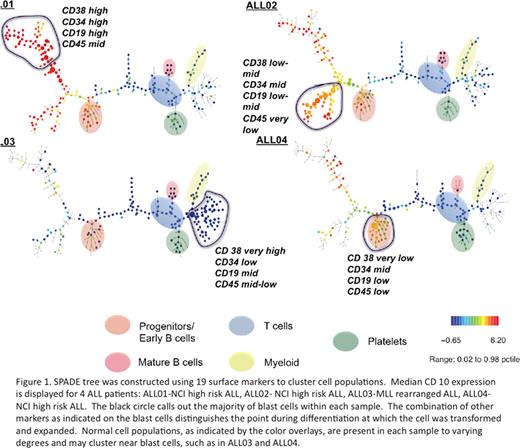Abstract
Abstract 753
Pediatric B Cell Acute Lymphoblastic Leukemia: Common and Unique Differentiation States Defined by Signaling Response States
When mutations or regulatory dysfunction drive inappropriate cell division or survival this sets the stage for cancer initiation or progression. At what point do cells in an early cancer veer from their normal cellular routines to no longer participate in the development of a normal cellular tissue architecture & differentiation heirarchy? Do they still attempt to play out their programming to some degree, or are they “free actors”? The fact that cancers of any given type appear to remain tied to phenotypic classification schemes is illustrated in traditional clinical stratification systems. Paradoxically, cancers are considered (by some) as “heterogeneous”, whereas as a class they appear to recapitulate patterns of clinical responses, gene expression, signaling states. To what extent are these repeated molecular patterns mirrored at the level of differentiation? We mapped, at the single cell level, patterns of expression of markers and phenotypic traits that might be similar or unique across patient subgroups of pediatric B-cell ALL samples using 35 parameter proteomic mass cytometry. Using the features assignable to each single cell, with a statistical reconstruction of most likely similarity of features in 35 dimensional space, we mapped a “common” differentiation tree previously unrecognized by conventional analyses, and demonstrate here how differences in certain markers distinguish, or create, common phenotypic co-expression features across these ALL patients, or suggest patient-specific derailing of differentiation associated with changes in signaling module expression states.
Cryopreserved cells were obtained from 8 pediatric B cell ALL patients under informed consent. 19 surface markers were used to cluster data into metacells of localized similarity displayed in a tree of local relationships via hierarchical cell lineage clustering and spanning-tree progression analysis of density-normalized events (SPADE) (Figure 1) (Bendall et al, Science 6 May2011; 332: 687–696).
The blast cell subpopulations comprised the areas of greatest density on the spanning trees–consistent with the fact that these cells are the most prevalent. Blast populations displayed variable expression of B cell precursor surface markers such as CD10, CD19, CD34 and CD38—even though clinical phenotyping placed all patients in a similar class. SPADE analysis detailed unexpected sub-branches prominently observed in certain patients, while absent or weakly represented in others. This confirms common signaling and differentiation states can be observed across patients, but individual patients can manifest unique and prevalent outgrowths of these common malignant differentiation states.
Three patients' disease appears to gain a transformative event during a common point at a “pre-B cell development state, leading to local expansion at this halted population of characteristic immunophenotype. Sample ALL04 appears to have an outgrowth of cells with the earliest pre-B cell progenitors, whereas ALL01 is consistent with a maturing pre B cell, gaining expression of CD45. Notably, ALL03, characterized by an MLL rearrangement, clusters with myeloid cells and is CD10 negative, suggesting transformation prior to lymphocyte commitment. The cellular responses to perturbation provides added structure to the cellular subsets; responses to stimulation of the preB cell receptor are present within the majority of blast populations for ALL01 but absent in most for ALL03 and ALL04. We will present this and other findings related to these patients, as well as application of this approach to other tumor types.
Conclusion:This high-dimensional immunophenotypic analysis of single cells from primary patient samples reveals an unseen developmental structure within pediatric B precursor acute lymphoblastic leukemia. The developmental stage at which the transformative event occurs informs the characteristic response to perturbation and critically, to drug treatment. *KD and ES contributed equally to this work.
Fantl:Nodality, Inc.: Equity Ownership.
Author notes
Asterisk with author names denotes non-ASH members.


This feature is available to Subscribers Only
Sign In or Create an Account Close Modal